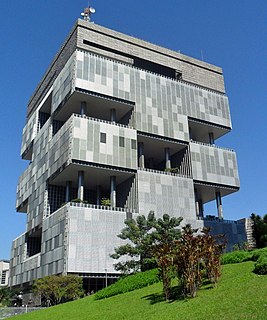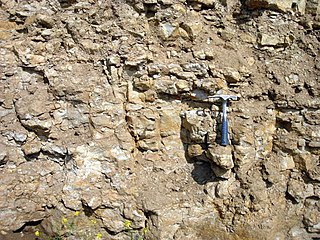
A power station, also referred to as a power plant and sometimes generating station or generating plant, is an industrial facility for the generation of electric power. Power stations are generally connected to an electrical grid.
Puget Sound Energy (PSE) is a Washington state energy utility providing electrical power and natural gas primarily in the Puget Sound region of the northwest United States. The utility serves electricity to more than 1.1 million customers in Island, King, Kitsap, Kittitas, Pierce, Skagit, Thurston, and Whatcom counties; and provides natural gas to 750,000 customers in King, Kittitas, Lewis, Pierce, Snohomish and Thurston counties. The company has a 6,000-square-mile (16,000 km2) electric and natural gas service area.

The Calcutta Electric Supply Corporation or CESC is the Kolkata-based flagship company of the RP-Sanjiv Goenka Group, born from the erstwhile RPG Group, under the chairmanship of businessman Sanjiv Goenka. It is an Indian electricity generation and the sole distribution company serving 567 square kilometres (219 sq mi) of area administered by the Kolkata municipal corporation, in the city of Kolkata, as well as parts of Howrah, Hooghly, 24 Parganas (North) and 24 Parganas (South) districts in the state of West Bengal. It serves 3.0 million consumers approximately, which includes domestic, industrial and commercial users.

Orot Rabin is a power station, as of 2016 Israel's largest. It is currently a 2.59GW coal-fired plant, although some of its generating units are in the process of conversion to a single-shaft combined-cycle gas power plant. It is situated on the Mediterranean coast in Hadera, Israel and is owned and operated by the Israel Electric Corporation (IEC). The older, unmodernised four of its total six coal-fuelled units will be closed by mid-2022 in order to eliminate this major source of air pollution in the country.

Veolia Environmental Services, formerly Onyx Environnement, is a division of Veolia Environnement. It employs nearly 78,000 staff, has operations in 35 countries around the world, and generated revenues of nearly €9.02 billion in 2009.

The Narva Power Plants are a power generation complex in and near Narva in Estonia, near the border with Leningrad Oblast, Russia. The complex consists of the world's two largest oil shale-fired thermal power plants, Eesti Power Plant and Balti Power Plant. In 2007, Narva Power Plants generated about 95% of total power production in Estonia. The complex is owned and operated by AS Narva Elektrijaamad, a subsidiary of Eesti Energia.
A.F.S.K. Hom Tov was a spin-off of the A.F.S.K. Industries Group located in Haifa, Israel. In 2006, the company claimed that it had patented technology for converting oil shale to shale oil.

Brazil is the largest energy consumer in South America. It is the most important oil and gas producer in the region and the world's largest ethanol fuel producer. The government agencies responsible for energy policy are the Ministry of Mines and Energy (MME), the National Council for Energy Policy (CNPE), the National Agency of Petroleum, Natural Gas and Biofuels (ANP) and the National Agency of Electricity (ANEEL). State-owned companies Petrobras and Eletrobras are the major players in Brazil's energy sector, as well as Latin America's.

The Lingan Generating Station is a 620 MW Canadian coal-fired electrical generating station located in the community of Lingan in Nova Scotia's Cape Breton Regional Municipality. Lingan is operated by Nova Scotia Power Inc. and is their largest generating station.

The history of the oil shale industry started in ancient times. The modern industrial use of oil shale for oil extraction dates to the mid-19th century and started growing just before World War I because of the mass production of automobiles and trucks and the supposed shortage of gasoline for transportation needs. Between the World Wars oil shale projects were begun in several countries.
Oil shale in China is an important source of unconventional oil. A total Chinese oil shale resource amounts of 720 billion tonnes, located in 80 deposits of 47 oil shale basins. This is equal to 48 billion tonnes of shale oil. At the same time there are speculations that the actual resource may even exceed the oil shale resource of the United States.

Oil shale is a strategic energy resource that constitutes about 4% of Estonia's gross domestic product. The oil shale industry in Estonia is one of the most developed in the world. In 2012, the country's oil shale industry employed 6,500 people – about 1% of the national workforce. Of all the oil shale fired power stations in the world, the two largest are in Estonia. In 2012, 70% of mined oil shale was used for electricity generation, accounting for about 85% of Estonia's total electricity production. A smaller proportion of the mined oil shale is used to produce shale oil, a type of synthetic oil extracted from shale by pyrolysis, which is sufficient to keep Estonia as the second largest shale oil producer in the world after China. In addition, oil shale and its products are used in Estonia for district heating and as a feedstock material for the cement industry.

The Galoter process is a shale oil extraction technology for a production of shale oil, a type of synthetic crude oil. In this process, the oil shale is decomposed into shale oil, oil shale gas, and spent residue. A decomposition is caused by mixing raw oil shale with a hot oil shale ash, generated by combustion of carbonaceous residue (semi-coke) in the spent residue. The process was developed in 1950s and it is used commercially for the shale oil production in Estonia. There are projects for further development of this technology and for expansion of its usage, e.g. in Jordan and USA.

This article describes the energy and electricity production, consumption and import in Egypt.

The energy sector of Ohio consists of thousands of companies and cities representing the oil, natural gas, coal, solar, wind energy, fuel cell, biofuel, geothermal, hydroelectric, and other related industries. Oil and natural gas accounts for $3.1 billion annually in sales while ethanol generates $750 million. The state is #2 nationally in solar manufacturing as Toledo is considered a national solar hub, nicknamed "Solar Valley". It is recognized internationally as the "Fuel Cell Corridor", and Hamilton is poised to become the biggest municipal provider of renewable energy in the Midwest, and one of the largest in the country, with over 70%. In 2008, the state led the country in alternative energy manufacturing according to Site Selection Magazine, while the natural gas industry has experienced growth due to the Great Shale Gas Rush.

Oil shale in Israel is widespread but an undeveloped resource, largely because of economic and technological constraints. Israeli oil shales belong to the group of Upper Cretaceous marinite deposits. Although oil-shale deposits may lie under as much as 15% of the country, only a small part of these are mineable. According to the Geological Survey of Israel, deposits that could have the biggest economic potential are located in the northern Negev, the largest being the Rotem-Yamin formation. For several decades, oil shale was used for small-scale power generation at Mishor Rotem. Several Israeli companies have proposed shale oil extraction; testing of the viability of the oil shale industry is currently being undertaken by Israel Energy Initiatives. However, as of 2011, there are no commercial oil shale operations in Israel.

The Ahtme Power Plant was an oil shale-fired power plant in Ahtme, Kohtla-Järve, Estonia. It was owned by VKG Soojus, a subsidiary of Viru Keemia Grupp. Until the end 2012, it supplied with heat Ahtme district of Kohtla-Järve and Jõhvi.

Most energy in Israel comes from fossil fuels. The country's total primary energy demand is significantly higher than its total primary energy production, relying heavily on imports to meet its energy needs. Total primary energy consumption was 1.037 quad (304 TWh) in 2016, or 26.2 Mtoe.
Butibori Power Project is a coal-based thermal power plant located at Butibori near Nagpur in the Indian state of Maharashtra. The power plant is operated by the Reliance Power.















